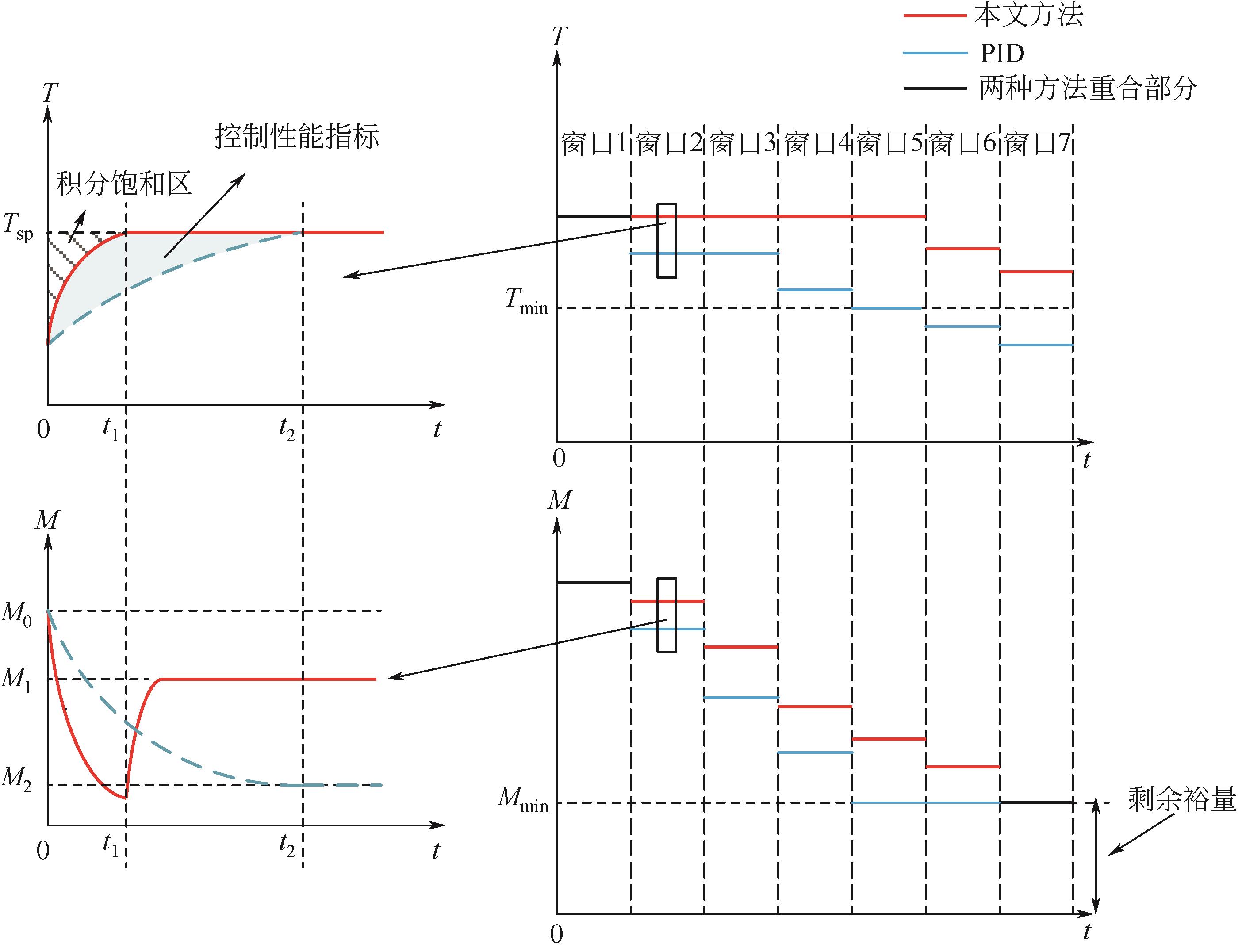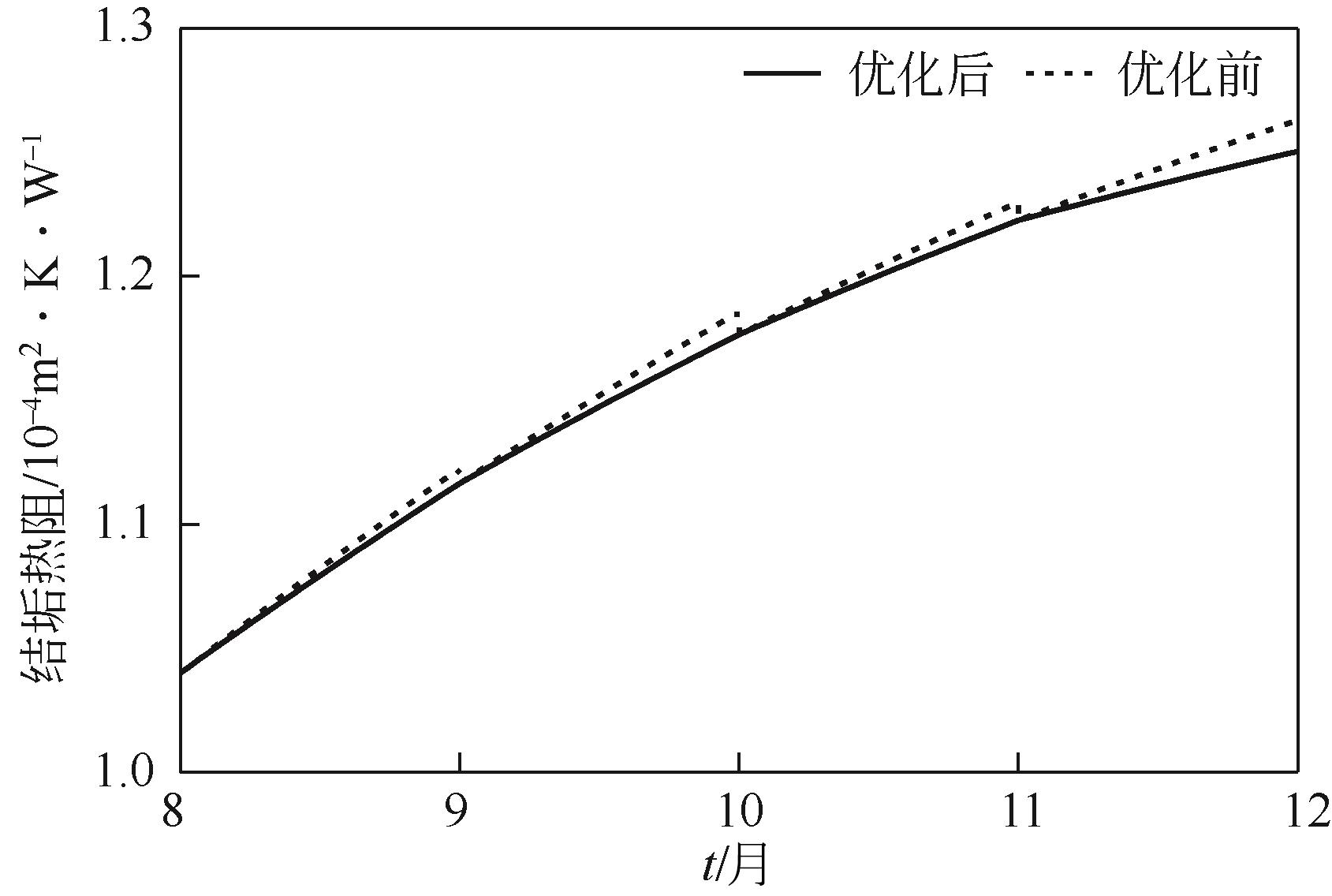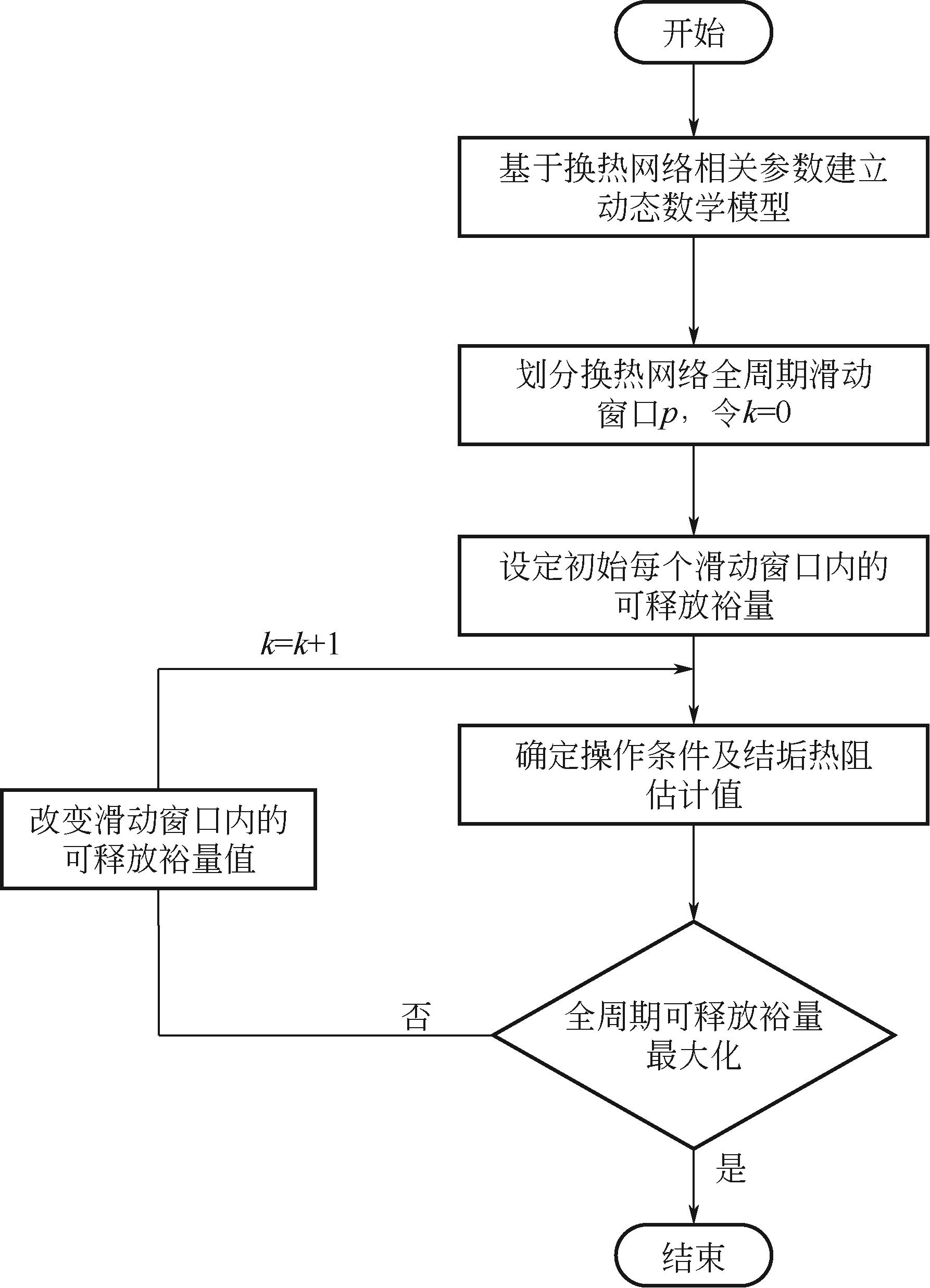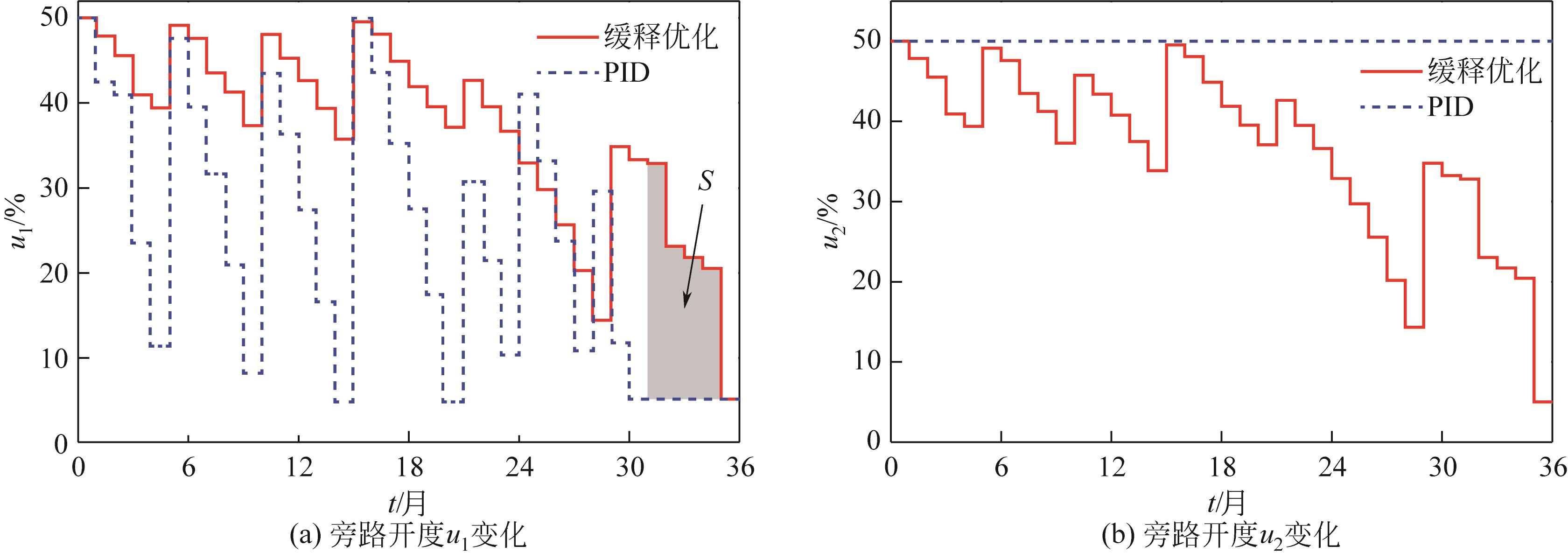Chemical Industry and Engineering Progress ›› 2023, Vol. 42 ›› Issue (3): 1195-1205.DOI: 10.16085/j.issn.1000-6613.2022-0938
• Chemical processes and equipment • Previous Articles Next Articles
Sliding window analysis and slow-release margin optimal control for heat exchanger networks based on full cycle sustainable energy saving
ZHU Tianyu( ), SUN Lin(
), SUN Lin( ), REN Chao, LUO Xionglin
), REN Chao, LUO Xionglin
- Research Institute of Automation, China University of Petroleum, Beijing 102249, China
-
Received:2022-05-20Revised:2022-06-28Online:2023-04-10Published:2023-03-15 -
Contact:SUN Lin
基于全周期持续节能的换热网络滑动窗口分析与裕量缓释优化控制
- 中国石油大学(北京)自动化系,北京 102249
-
通讯作者:孙琳 -
作者简介:朱添宇(1998—),男,硕士研究生,研究方向为系统工程。E-mail:15911057786@163.com。 -
基金资助:中国石油大学(北京)科研基金(2462020YXZZ023)
CLC Number:
Cite this article
ZHU Tianyu, SUN Lin, REN Chao, LUO Xionglin. Sliding window analysis and slow-release margin optimal control for heat exchanger networks based on full cycle sustainable energy saving[J]. Chemical Industry and Engineering Progress, 2023, 42(3): 1195-1205.
朱添宇, 孙琳, 任超, 罗雄麟. 基于全周期持续节能的换热网络滑动窗口分析与裕量缓释优化控制[J]. 化工进展, 2023, 42(3): 1195-1205.
share this article
Add to citation manager EndNote|Ris|BibTeX
URL: https://hgjz.cip.com.cn/EN/10.16085/j.issn.1000-6613.2022-0938
| 物流名称 | 缩写 | 流量 /kg·s-1 | 热容 /kW | 输入温度 /℃ | 输出温度 /℃ |
|---|---|---|---|---|---|
| 常顶油 | LAGO | 3.93 | 3613 | 114 | 86 |
| 常二线 | MAGO | 12.74 | 2670 | 200 | 118 |
| 常三线 | HAGO | 10.16 | 2701 | 230 | 120 |
| 减一中 | LVCO | 8.31 | 1261 | 174 | 110 |
| 减二线 | MVGO | 18.34 | 4338 | 222 | 116 |
| 减三线 | HVGO | 4.24 | 902 | 218 | 122.5 |
| 减底渣油(1) | VR(1) | 27.36 | 6742 | 227.5 | 124 |
| 减底渣油(2) | VR(2) | 27.36 | 5622 | 205 | 120.5 |
| 原油 | CRUDE | 60.95 | 2.8×104 | 55 | 162 |
| 物流名称 | 缩写 | 流量 /kg·s-1 | 热容 /kW | 输入温度 /℃ | 输出温度 /℃ |
|---|---|---|---|---|---|
| 常顶油 | LAGO | 3.93 | 3613 | 114 | 86 |
| 常二线 | MAGO | 12.74 | 2670 | 200 | 118 |
| 常三线 | HAGO | 10.16 | 2701 | 230 | 120 |
| 减一中 | LVCO | 8.31 | 1261 | 174 | 110 |
| 减二线 | MVGO | 18.34 | 4338 | 222 | 116 |
| 减三线 | HVGO | 4.24 | 902 | 218 | 122.5 |
| 减底渣油(1) | VR(1) | 27.36 | 6742 | 227.5 | 124 |
| 减底渣油(2) | VR(2) | 27.36 | 5622 | 205 | 120.5 |
| 原油 | CRUDE | 60.95 | 2.8×104 | 55 | 162 |
| 时间/月 | 缓释优化/℃ | 时间/月 | PID/℃ |
|---|---|---|---|
| 1~5 | 166.80 | 1~5 | 166.80 |
| 6~10 | 165.50 | 6~10 | 165.50 |
| 11~15 | 164.30 | 11~15 | 164.30 |
| 16~21 | 162.80 | 16~21 | 162.80 |
| 22~29 | 162.00 | 22~24 | 162.00 |
| 30~36 | 160.50 | 25~28 | 161.00 |
| — | — | 29~31 | 160.40 |
| 时间/月 | 缓释优化/℃ | 时间/月 | PID/℃ |
|---|---|---|---|
| 1~5 | 166.80 | 1~5 | 166.80 |
| 6~10 | 165.50 | 6~10 | 165.50 |
| 11~15 | 164.30 | 11~15 | 164.30 |
| 16~21 | 162.80 | 16~21 | 162.80 |
| 22~29 | 162.00 | 22~24 | 162.00 |
| 30~36 | 160.50 | 25~28 | 161.00 |
| — | — | 29~31 | 160.40 |
| 1 | YUAN Fang, CHEN Qun. Two energy conservation principles in convective heat transfer optimization[J]. Energy, 2011, 36(9): 5476-5485. |
| 2 | CHEN Qun, WANG Moran, PAN Ning, et al. Optimization principles for convective heat transfer[J]. Energy, 2009, 34(9): 1199-1206. |
| 3 | HAMEDI H, KARIMI I A, GUNDERSEN T. Simulation-based approach for integrating work within heat exchange networks for sub-ambient processes[J]. Energy Conversion and Management, 2020, 203: 112276. |
| 4 | 蒋立本, 冯霄, 丁生华, 等. 受网络夹点控制的装置的改造分析[J]. 高校化学工程学报, 2001, 15(2): 161-166. |
| JIANG Liben, FENG Xiao, DING Shenghua, et al. Analysis of retrofitting the process controlled by network pinch[J]. Journal of Chemical Engineering of Chinese Universities, 2001, 15(2): 161-166. | |
| 5 | 陈鹏鹏, 李继龙, 樊婕, 等. 考虑污垢增长的柔性换热器网络综合[J]. 华东理工大学学报(自然科学版), 2013, 39(1): 51-54, 60. |
| CHEN Pengpeng, LI Jilong, FAN Jie, et al. Synthesis of flexible heat exchanger network with fouling growth[J]. Journal of East China University of Science and Technology (Natural Science Edition), 2013, 39(1): 51-54, 60. | |
| 6 | LUGO-GRANADOS H, PICÓN NÚÑEZ M. Modelling scaling growth in heat transfer surfaces and its application on the design of heat exchangers[J]. Energy, 2018, 160: 845-854. |
| 7 | ZHENG K, LOU H H, WANG J, et al. A method for flexible heat exchanger network design under severe operation uncertainty[J]. Chemical Engineering & Technology, 2013, 36(5): 757-765. |
| 8 | KONUKMAN A E Ş, AKMAN U, ÇAMURDAN M C. Optimal design of controllable heat-exchanger networks under multi-directional resiliency-target constraints[J]. Computers & Chemical Engineering, 1995, 19: 149-154. |
| 9 | WANG L K, SUNDÉN B. Detailed simulation of heat exchanger networks for flexibility consideration[J]. Applied Thermal Engineering, 2001, 21(12): 1175-1184. |
| 10 | SHILLING R L, RUDY M P, RUDY T M. Risk-based design margin selection for heat exchangers[J]. Heat Transfer Engineering, 2011, 32(3/4): 307-313. |
| 11 | SHILLING R L. Fouling and uncertainty margins in tubular heat exchanger design: an alternative[J]. Heat Transfer Engineering, 2012, 33(13): 1094-1104. |
| 12 | ERNST P, FIEG G, LUO X. Efficient synthesis of large-scale heat exchanger networks using monogenetic algorithm[J]. Heat and Mass Transfer, 2010, 46(10): 1087-1096. |
| 13 | 夏车奎, 罗雄麟, 孙琳. 基于全周期节能的有旁路换热网络裕量优化设计[J].化工学报, 2012, 63(5): 1449-1458. |
| XIA Chekui, LUO Xionglin, SUN Lin. Margin optimal design of heat exchanger network with bypasses based on life cycle energy saving[J]. CIESC Journal, 2012, 63(5): 1449-1458. | |
| 14 | 倪锦, 崔国民, 姜慧, 等. 换热网络的柔性识别及基于旁路调节的运行优化[J]. 化工进展, 2010, 29(1): 17-24. |
| NI Jin, CUI Guomin, JIANG Hui, et al. Flexibility identification and operation optimization based on by-pass adjustment of heat exchanger networks[J]. Chemical Industry and Engineering Progress, 2010, 29(1): 17-24. | |
| 15 | 汪旭, 冯霄. 基于启发式方法的弹性换热网络的合成[J]. 计算机与应用化学, 2010, 27(10): 1349-1352. |
| WANG Xu, FENG Xiao. Synthesis of flexible heat exchanger network based on heuristic approach[J]. Computers and Applied Chemistry, 2010, 27(10): 1349-1352. | |
| 16 | MARSELLE D F, MORARI M, RUDD D F. Design of resilient processing plants (II): Design and control of energy management systems[J]. Chemical Engineering Science, 1982, 37(2): 259-270. |
| 17 | MATHISEN K W, SKOGESTAD S, WOLFF E A. Bypass selection for control of heat exchanger networks[J]. Computers & Chemical Engineering, 1992, 16: S263-S272. |
| 18 | UZTÜRK D, AKMAN U. Centralized and decentralized control of retrofit heat-exchanger networks[J]. Computers & Chemical Engineering, 1997, 21: S373-S378. |
| 19 | ARBAOUI M, HASSIMI L V, SEGUIN D, et al. Counter-current tubular heat exchanger: Modeling and adaptive predictive functional control[J]. Applied Thermal Engineering, 2007, 27: 2332-2338. |
| 20 | LUYBEN W L. Heat-exchanger bypass control[J]. Industrial & Engineering Chemistry Research, 2011, 50(2): 965-973. |
| 21 | DELATORE F, NOVAZZI L F, LEONARDI F, et al. Multivariable optimal control of a heat exchanger network with bypasses[J]. Brazilian Journal of Chemical Engineering, 2016, 33(1): 133-143. |
| 22 | HERNÁNDEZ S, BALCAZAR-LÓPEZ L, SÁNCHEZ-MÁRQUEZ J A, et al. Controllability and operability analysis of heat exchanger networks including bypasses[J]. Chemical and Biochemical Engineering Quarterly, 2010, 24(1): 23-28. |
| 23 | 张少凤, 张清勇, 杨叶森, 等. 基于滑动窗口和LSTM神经网络的锂离子电池建模方法[J]. 储能科学与技术, 2022, 11(1): 228-239. |
| ZHANG Shaofeng, ZHANG Qingyong, YANG Yesen, et al. Lithium-ion battery model based on sliding window and long short term memory neural network[J]. Energy Storage Science and Technology, 2022, 11(1): 228-239. | |
| 24 | 杨世强, 罗晓宇, 乔丹, 等. 基于滑动窗口和动态规划的连续动作分割与识别[J]. 计算机应用, 2019, 39(2): 348-353. |
| YANG Shiqiang, LUO Xiaoyu, QIAO Dan, et al. Continuous action segmentation and recognition based on sliding window and dynamic programming[J]. Journal of Computer Applications, 2019, 39(2): 348-353. | |
| 25 | 刘俊扬, 张仲荣, 祁楌捷. 基于滑动窗口和LSTM的PM2.5浓度预测模型[J]. 齐齐哈尔大学学报(自然科学版), 2022, 38(1): 87-94. |
| LIU Junyang, ZHANG Zhongrong, QI Yanjie. PM2.5 concentration prediction model based on sliding window and LSTM[J]. Journal of Qiqihar University (Natural Science Edition), 2022, 38(1): 87-94. | |
| 26 | 徐江, 张鸿宇, 李军怀, 等. 基于滑动窗口的流数据并行处理方法[J]. 重型机械, 2021(1): 29-36. |
| XU Jiang, ZHANG Hongyu, LI Junhuai, et al. Parallel processing method of steam data based on sliding window[J]. Heavy Machinery, 2021(1): 29-36. | |
| 27 | SUN Lin, ZHA Xinlang, LUO Xionglin. Coordination between bypass control and economic optimization for heat exchanger network[J]. Energy, 2018, 160: 318-329. |
| 28 | 缪应锋, 姚庆华, 李智雄, 等. 基于梯度估计的非线性系统最优控制及仿真[J]. 计算机系统应用, 2016, 25(11): 260-264. |
| MIAO Yingfeng, YAO Qinghua, LI Zhixiong, et al. Optimal control and simulation of nonlinear systems based on gradient estimation[J]. Computer Systems & Applications, 2016, 25(11): 260-264. | |
| 29 | 任超, 孙琳, 罗雄麟. 换热器因应结垢慢时变的控制系统重构分析[J]. 化工学报, 2021, 72(10): 5273-5283. |
| REN Chao, SUN Lin, LUO Xionglin. Analysis on the reconfiguration of the control system of the heat exchanger in response to the slow and time-varying fouling[J]. CIESC Journal, 2021, 72(10): 5273-5283. | |
| 30 | 杨辉, 邱亦丰, 李宁, 等. 通用型阀门控制器研究与应用[Z]. 陕西煤业化工集团有限责任公司, 2016-08-19. |
| YANG Hui, QIU Yifeng, LI Ning, et al. Research and application of universal valve controller[Z]. Shaanxi coal and Chemical Industry Group Co., Ltd., 2016-08-19. |
| [1] | JIANG Ning, ZHANG Yuanyi, FAN Wei, ZHAO Shichao, XU Xinjie, XU Yingjie. Cleaning decision of heat exchanger network based on intelligent prediction and mechanism [J]. Chemical Industry and Engineering Progress, 2022, 41(4): 1781-1792. |
| [2] | XU Yue, CUI Guomin. Analyzing optimization performance of heat exchanger network synthesis based on nodes' adjustment strategy [J]. Chemical Industry and Engineering Progress, 2021, 40(7): 3608-3616. |
| [3] | Yingdi SHAO, Jianhang HU, Huili LIU, Zhengda CAI. Energy efficiency analysis of heat exchange network of isobutylene purification unit [J]. Chemical Industry and Engineering Progress, 2020, 39(S2): 57-65. |
| [4] | Ning JIANG, Wei FAN, Xiaodong XIE, Fengyuan GUO, Enteng LI, Shichao ZHAO. Comparative study of NSGA-Ⅱ and NSGA-Ⅲ on multi-objective optimization of heat exchanger network [J]. Chemical Industry and Engineering Progress, 2020, 39(7): 2534-2547. |
| [5] | Geman SU, Guomin CUI, Yuan XIAO, Qianqian ZHAO. Influence analysis and strategy improvement of heat exchanger generation frequency in heat exchanger networks optimization [J]. Chemical Industry and Engineering Progress, 2020, 39(10): 3879-3891. |
| [6] | Chang LIU,Shiyu LI,Xiaolan XIE. Integration of heat storage in batch processes considering additional approach temperature difference for indirect heat transfer [J]. Chemical Industry and Engineering Progress, 2020, 39(1): 72-79. |
| [7] | Geman SU,Guomin CUI,Zhongkai BAO,Yuan XIAO,Aowei JIANG. Influence analysis and enhancement strategy of infeasible solutions for heat exchanger network optimization with RWCE [J]. Chemical Industry and Engineering Progress, 2020, 39(1): 14-25. |
| [8] | Ning JIANG,Xiaodong XIE,Wei FAN,Yingjie XU. Data-driven optimization retrofit method with fixed topology structure for heat exchanger network [J]. Chemical Industry and Engineering Progress, 2019, 38(10): 4452-4460. |
| [9] | Yunqing DONG, Zheng WANG, Yifan XU, Yanxia YANG, Xiaoping JIA, Fang WANG. Heat exchanger network bypass position determination based on complex network control theory [J]. Chemical Industry and Engineering Progress, 2019, 38(07): 3046-3055. |
| [10] | Ning JIANG, Fengyuan GUO, Wenqiao HAN, Huajing LIU, Lu LIN. 3E Optimization of heat exchanger network system based on non-counterflow heat transfer [J]. Chemical Industry and Engineering Progress, 2019, 38(02): 761-771. |
| [11] | JIANG Ning, HAN Wenqiao, GUO Fengyuan, XU Yingjie. Optimization of heat exchanger network retrofit based on actual heat load distribution [J]. Chemical Industry and Engineering Progress, 2018, 37(08): 2935-2941. |
| [12] | DENG Weidong, CUI Guomin, CHEN Jiaxing, ZHU Yushuang. Heat exchange network optimization by inverse gradient evolution strategy with penalty [J]. Chemical Industry and Engineering Progress, 2018, 37(07): 2500-2509. |
| [13] | ZHANG Hongliang, CUI Guomin, ZHU Yushuang, HUANG Xiaohuang. Optimization and analysis of specific heat exchanger network cases [J]. Chemical Industry and Engineering Progress, 2018, 37(05): 1692-1701. |
| [14] | XIAO Wu, SHI Zhaoxia, JIANG Xiaobin, LI Xiangcun, WU Xuemei, HE Gaohong, LUO Li. Research progress on heat exchanger network considering heat transfer enhancement of shell-and-tube exchangers [J]. Chemical Industry and Engineering Progress, 2018, 37(04): 1267-1275. |
| [15] | FENG Yuanli, XIA Li, XIANG Shuguang. Comparative study on heat exchanger network adaptability based on entropy analysis and entransy analysis [J]. Chemical Industry and Engineering Progress, 2017, 36(10): 3657-3664. |
| Viewed | ||||||
|
Full text |
|
|||||
|
Abstract |
|
|||||









